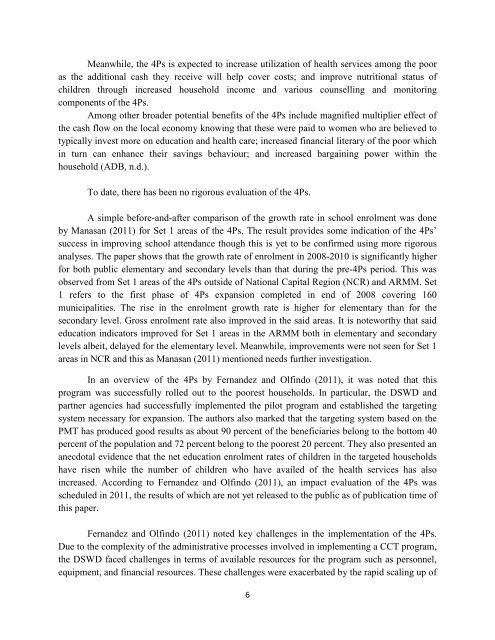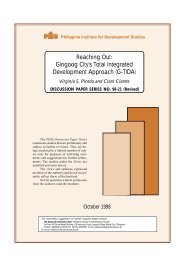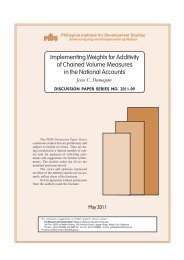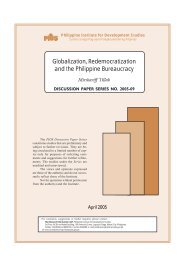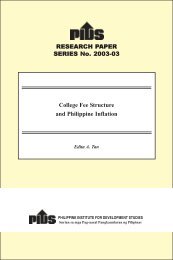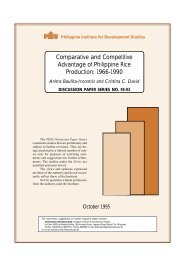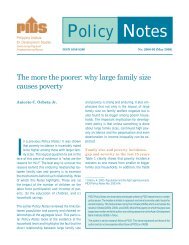Conditional Cash Transfer Program in the Philippines: Is It Reaching ...
Conditional Cash Transfer Program in the Philippines: Is It Reaching ...
Conditional Cash Transfer Program in the Philippines: Is It Reaching ...
Create successful ePaper yourself
Turn your PDF publications into a flip-book with our unique Google optimized e-Paper software.
Meanwhile, <strong>the</strong> 4Ps is expected to <strong>in</strong>crease utilization of health services among <strong>the</strong> pooras <strong>the</strong> additional cash <strong>the</strong>y receive will help cover costs; and improve nutritional status ofchildren through <strong>in</strong>creased household <strong>in</strong>come and various counsell<strong>in</strong>g and monitor<strong>in</strong>gcomponents of <strong>the</strong> 4Ps.Among o<strong>the</strong>r broader potential benefits of <strong>the</strong> 4Ps <strong>in</strong>clude magnified multiplier effect of<strong>the</strong> cash flow on <strong>the</strong> local economy know<strong>in</strong>g that <strong>the</strong>se were paid to women who are believed totypically <strong>in</strong>vest more on education and health care; <strong>in</strong>creased f<strong>in</strong>ancial literary of <strong>the</strong> poor which<strong>in</strong> turn can enhance <strong>the</strong>ir sav<strong>in</strong>gs behaviour; and <strong>in</strong>creased barga<strong>in</strong><strong>in</strong>g power with<strong>in</strong> <strong>the</strong>household (ADB, n.d.).To date, <strong>the</strong>re has been no rigorous evaluation of <strong>the</strong> 4Ps.A simple before-and-after comparison of <strong>the</strong> growth rate <strong>in</strong> school enrolment was doneby Manasan (2011) for Set 1 areas of <strong>the</strong> 4Ps. The result provides some <strong>in</strong>dication of <strong>the</strong> 4Ps’success <strong>in</strong> improv<strong>in</strong>g school attendance though this is yet to be confirmed us<strong>in</strong>g more rigorousanalyses. The paper shows that <strong>the</strong> growth rate of enrolment <strong>in</strong> 2008-2010 is significantly higherfor both public elementary and secondary levels than that dur<strong>in</strong>g <strong>the</strong> pre-4Ps period. This wasobserved from Set 1 areas of <strong>the</strong> 4Ps outside of National Capital Region (NCR) and ARMM. Set1 refers to <strong>the</strong> first phase of 4Ps expansion completed <strong>in</strong> end of 2008 cover<strong>in</strong>g 160municipalities. The rise <strong>in</strong> <strong>the</strong> enrolment growth rate is higher for elementary than for <strong>the</strong>secondary level. Gross enrolment rate also improved <strong>in</strong> <strong>the</strong> said areas. <strong>It</strong> is noteworthy that saideducation <strong>in</strong>dicators improved for Set 1 areas <strong>in</strong> <strong>the</strong> ARMM both <strong>in</strong> elementary and secondarylevels albeit, delayed for <strong>the</strong> elementary level. Meanwhile, improvements were not seen for Set 1areas <strong>in</strong> NCR and this as Manasan (2011) mentioned needs fur<strong>the</strong>r <strong>in</strong>vestigation.In an overview of <strong>the</strong> 4Ps by Fernandez and Olf<strong>in</strong>do (2011), it was noted that thisprogram was successfully rolled out to <strong>the</strong> poorest households. In particular, <strong>the</strong> DSWD andpartner agencies had successfully implemented <strong>the</strong> pilot program and established <strong>the</strong> target<strong>in</strong>gsystem necessary for expansion. The authors also marked that <strong>the</strong> target<strong>in</strong>g system based on <strong>the</strong>PMT has produced good results as about 90 percent of <strong>the</strong> beneficiaries belong to <strong>the</strong> bottom 40percent of <strong>the</strong> population and 72 percent belong to <strong>the</strong> poorest 20 percent. They also presented ananecdotal evidence that <strong>the</strong> net education enrolment rates of children <strong>in</strong> <strong>the</strong> targeted householdshave risen while <strong>the</strong> number of children who have availed of <strong>the</strong> health services has also<strong>in</strong>creased. Accord<strong>in</strong>g to Fernandez and Olf<strong>in</strong>do (2011), an impact evaluation of <strong>the</strong> 4Ps wasscheduled <strong>in</strong> 2011, <strong>the</strong> results of which are not yet released to <strong>the</strong> public as of publication time ofthis paper.Fernandez and Olf<strong>in</strong>do (2011) noted key challenges <strong>in</strong> <strong>the</strong> implementation of <strong>the</strong> 4Ps.Due to <strong>the</strong> complexity of <strong>the</strong> adm<strong>in</strong>istrative processes <strong>in</strong>volved <strong>in</strong> implement<strong>in</strong>g a CCT program,<strong>the</strong> DSWD faced challenges <strong>in</strong> terms of available resources for <strong>the</strong> program such as personnel,equipment, and f<strong>in</strong>ancial resources. These challenges were exacerbated by <strong>the</strong> rapid scal<strong>in</strong>g up of6


